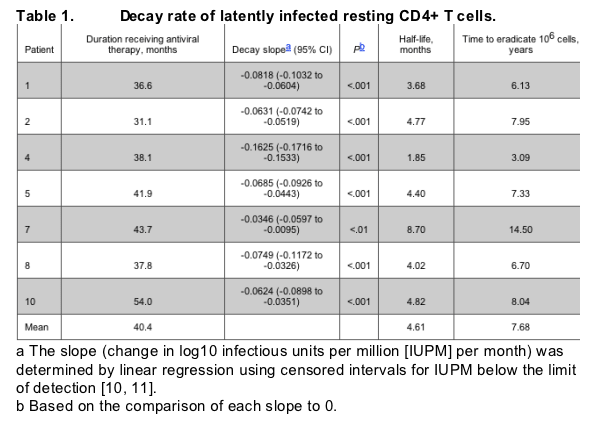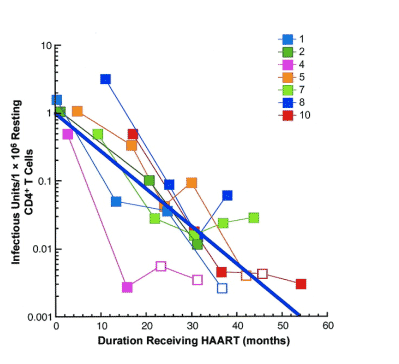| |
Decay of the HIV Reservoir in Patients Receiving Antiretroviral Therapy for Extended Periods: Implications for Eradication of Virus
|
| |
| |
Journal of Infectious Diseases, June 2007
Tae-Wook Chun,1 J. Shawn Justement,1 Susan Moir,1 Claire W. Hallahan,2 Janine Maenza,3 James I. Mullins,3,4,5 Ann C. Collier,3 Lawrence Corey,3,5 and Anthony S. Fauci1
1Laboratory of Immunoregulation and 2Biostatistics Research Branch, National Institute of Allergy and Infectious Diseases, National Institutes of Health, Bethesda, Maryland; Departments of 3Medicine, 4Microbiology, and 5Laboratory Medicine, University of Washington School of Medicine, Seattle
(See the editorial commentary by Margolis and Archin)
ABSTRACT:
The persistence of latently infected resting CD4+ T cells has been clearly demonstrated in human immunodeficiency virus (HIV)-infected individuals receiving effective antiviral therapy. However, estimates of the half-life of this viral reservoir have been quite divergent. We demonstrate clear evidence for decay of this HIV reservoir in patients who initiated antiviral therapy early in infection. The half-life of this latent viral reservoir was estimated to be 4.6 months. It is projected that it will take up to 7.7 years of continuous therapy to completely eliminate latently infected resting CD4+ T cells in infected individuals who initiate antiviral therapy early in HIV infection.
Despite the development of successful therapeutic strategies, it has not been possible to eradicate HIV in infected individuals, mainly because of the persistence of various viral reservoirs [1-5]. Among these reservoirs, a pool of latently infected cells in the resting CD4+ T cell compartment has been one of the most extensively studied to date and is considered to be a major impediment to HIV eradication [1-3]. Given that eradication of HIV is not possible as long as such infected cells persist, precise measurements of the half-life of this viral reservoir could shed light on the feasibility of completely eliminating HIV in patients receiving antiviral therapy, particularly as more potent therapeutic regimens become available, such as those that might contain an entry or integrase inhibitor; integration of provirus is critical for the establishment and replenishment of latently infected CD4+ T cells. However, previous studies addressing this subject have generated conflicting data (half-life ranging from 6.4 to 44.2 months) [6, 7]. To further delineate the decay rate of HIV and the possibility of the eradication of virus in a subset of patients who initiated antiviral therapy early in infection, we conducted longitudinal measurements of the frequency of resting CD4+ T cells carrying replication-competent virus from a previously identified cohort of patients in whom antiviral therapy was initiated soon after primary infection and in whom viral replication was extremely well controlled by therapy [8].
Patients, materials, and methods. Seven HIV-infected individuals who had received antiviral therapy for an average of 40.4 months (range, 31.1-54 months) (table 1) were studied. These individuals were participants in an earlier study [8]. The average time between the onset of symptoms of primary HIV infection and initiation of antiviral therapy was 2.7 months (range, 0.3-4.4 months). All patients received various antiviral regimens containing at least 1 protease inhibitor in addition to 2 reverse-transcriptase inhibitors and achieved maximal suppression of plasma viremia. Leukapheresis was conducted in accordance with protocols approved by the institutional review boards of the University of Washington, Seattle, and the National Institute of Allergy and Infectious Diseases, National Institutes of Health. Multiple leukapheresis procedures followed by isolation of resting CD4+ T cells were conducted on each of the patients studied. Purified resting CD4+ T cells (up to 350 million cells) were subjected to a high-input coculture assay, and the frequency of cells carrying replication-competent HIV was calculated as described elsewhere [9].

Results.
As shown in figure 1, decay of the latent viral reservoir was evident in all 7 individuals studied. Linear regression using censored intervals for infectious units per million resting CD4+ T cells below the level of detection with first-order kinetics was applied [10, 11]. On the basis of this analysis, the half-life of the latent reservoir was estimated to be 4.6 months (range, 1.9-8.7 months). With an assumption that 1 X 106 latently infected resting CD4+ T cells are present in an infected person, the projected time for complete elimination of HIV in the above cellular compartment would be 7.7 years (range, 3.1-14.5 years).
Figure 1. Decay of latently infected resting CD4+ T cells in patients receiving effective antiviral therapy. The data points for each individual are shown. The open symbols indicate values below the limit of detection. The solid line indicates the mean rate of decay.

Discussion. The persistence of HIV in the resting CD4+ T cell compartment has long been recognized as one of the major obstacles to achieving eradication of virus in infected individuals receiving effective antiviral therapy [1-3]. Previous studies have demonstrated that a long intrinsic half-life of the latent viral reservoir [7], along with low levels of residual viral replication in the periphery [5] and in lymphoid tissue [12], make eradication of virus all but impossible in infected individuals in whom antiviral therapy was initiated during the chronic phase of infection. However, the present study demonstrates that decay of the latent viral reservoir does occur in resting CD4+ T cells in patients in whom antiviral therapy was initiated during the early phase of HIV infection. The present study has potentially significant clinical implications, especially regarding the design of future therapeutic strategies aimed at eradicating HIV in infected individuals. Although ongoing HIV replication cannot be ruled out in infected individuals who began antiviral therapy early in HIV infection, it would be of considerable interest to begin to pursue evidence for the possibility of eradicating HIV in such individuals whose duration of therapy has reached the above figure. In this regard, recent studies have suggested that initiation of treatment shortly after seroconversion may facilitate decay of HIV in the CD4+ T cell compartment both in blood [13] and in gut-associated lymphoid tissues [14] in infected individuals receiving relatively short-term antiviral therapy. It is conceivable, if not likely, that eradication is not possible, at least with the currently available antiretroviral drug regimens; however, we are approaching the opportunity to address adequately this question based on projected half-lives of viral reservoirs in certain patients whose plasma viremia has been suppressed over extended periods of time. Of note, we have previously demonstrated that HIV rebounded on discontinuation of antiviral therapy in 2 of 2 chronically infected patients who were aviremic for 2-3 years and in whom no detectable virus could be demonstrated in CD4+ T cells in peripheral blood or lymph nodes [15]. However, these patients initiated antiviral therapy during the chronic phase of viral infection, and the duration of antiviral therapy was considerably less than 7.7 years, the projected time to eliminate HIV in the latent viral reservoir as demonstrated in the present study. Given that it has already been 10 years since antiviral therapy became available on a widespread basis, there are a number of patients who are or will soon fall into this category. A close monitoring of the size of viral reservoirs in patients who initiated antiviral therapy early in infection after successful control of HIV for longer than 8 years and who elect to discontinue therapy will be of considerable value in assessing the feasibility of eradication of HIV.
Acknowledgments
We thank the patients for their participation in this study. We also thank Dr. M. Michelle Berrey, Eric Peterson, Kurt Diem, and Claire Stevens for their invaluable assistance in the execution of this study.
References
1. Chun TW, Stuyver L, Mizell SB, et al. Presence of an inducible HIV-1 latent reservoir during highly active antiretroviral therapy. Proc Natl Acad Sci USA 1997; 94:13193-7. First citation in article | PubMed | CrossRef
2. Finzi D, Hermankova M, Pierson T, et al. Identification of a reservoir for HIV-1 in patients on highly active antiretroviral therapy. Science 1997; 278:1295-300. First citation in article | PubMed | CrossRef
3. Wong JK, Hezareh M, Gunthard HF, et al. Recovery of replication-competent HIV despite prolonged suppression of plasma viremia. Science 1997; 278:1291-5. First citation in article | PubMed | CrossRef
4. Chun TW, Fauci AS. Latent reservoirs of HIV: obstacles to the eradication of virus. Proc Natl Acad Sci USA 1999; 96:10958-61. First citation in article | PubMed | CrossRef
5. Chun TW, Nickle DC, Justement JS, et al. HIV-infected individuals receiving effective antiviral therapy for extended periods of time continually replenish their viral reservoir. J Clin Invest 2005; 115:3250-5. First citation in article | PubMed | CrossRef
6. Zhang L, Ramratnam B, Tenner-Racz K, et al. Quantifying residual HIV-1 replication in patients receiving combination antiretroviral therapy. N Engl J Med 1999; 340:1605-13. First citation in article | PubMed | CrossRef
7. Siliciano JD, Kajdas J, Finzi D, et al. Long-term follow-up studies confirm the stability of the latent reservoir for HIV-1 in resting CD4+ T cells. Nat Med 2003; 9:727-8. First citation in article | PubMed | CrossRef
8. Chun TW, Engel D, Berrey MM, Shea T, Corey L, Fauci AS. Early establishment of a pool of latently infected, resting CD4+ T cells during primary HIV-1 infection. Proc Natl Acad Sci USA 1998; 95:8869-73. First citation in article | PubMed | CrossRef
9. Chun TW, Engel D, Mizell SB, et al. Effect of interleukin-2 on the pool of latently infected, resting CD4+ T cells in HIV-1-infected patients receiving highly active anti-retroviral therapy. Nat Med 1999; 5:651-5. First citation in article | PubMed | CrossRef
10. SAS Institute. SAS/STAT user's guide. Cary, NC: SAS Institute, 1999. First citation in article
11. Di Mascio M, Dornadula G, Zhang H, et al. In a subset of subjects on highly active antiretroviral therapy, human immunodeficiency virus type 1 RNA in plasma decays from 50 to <5 copies per milliliter, with a half-life of 6 months. J Virol 2003; 77:2271-5. First citation in article | PubMed | CrossRef
12. Poles MA, Boscardin WJ, Elliott J, et al. Lack of decay of HIV-1 in gut-associated lymphoid tissue reservoirs in maximally suppressed individuals. J Acquir Immune Defic Syndr 2006; 43:65-8. First citation in article | PubMed | CrossRef
13. Strain MC, Little SJ, Daar ES, et al. Effect of treatment, during primary infection, on establishment and clearance of cellular reservoirs of HIV-1. J Infect Dis 2005; 191:1410-8. First citation in article | Full Text | PubMed
14. Guadalupe M, Sankaran S, George MD, et al. Viral suppression and immune restoration in the gastrointestinal mucosa of human immunodeficiency virus type 1-infected patients initiating therapy during primary or chronic infection. J Virol 2006; 80:8236-47. First citation in article | PubMed | CrossRef
15. Chun TW, Davey RT Jr, Engel D, Lane HC, Fauci AS. Re-emergence of HIV after stopping therapy. Nature 1999; 401:874-5. First citation in article | PubMed | CrossRef
|
|
| |
| |
|
|
|